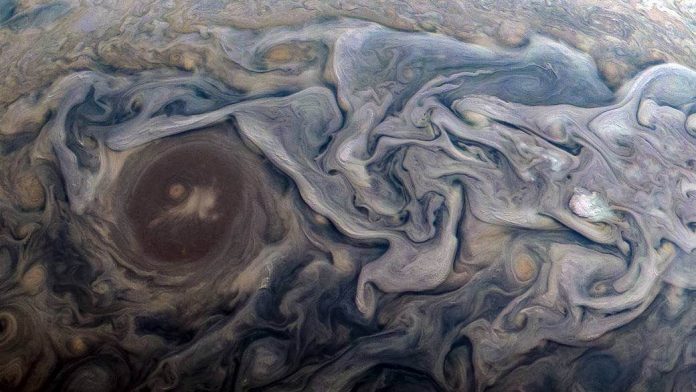No, that’s not Vincent van Gogh’s “Starry Night” painting, but the swirls are pretty convincing. NASA’s Juno spacecraft has sent back some lovely new photos of Jupiter that give us all of the Post-Impressionist feels.
Jupiter is quite dramatic, in case you forgot about the Great Red Spot, the gas giant’s perpetual giant storm. That’s part of why Juno’s steady stream of images since arriving at Jupiter in 2016 have been so amazing.
In the new images, atmospheric features in Jupiter’s northern hemisphere showcase clouds that swirl around a circle in a jet stream region called Jet N6.
Juno took the photo 8,000 miles from the cloud tops during its 18th close flyby of Jupiter on February 12.
The image has been color-enhanced and rotated by citizen scientist Kevin M. Gill. In case you’re wondering what raw images look like when Juno captures them, you can browse and play around with them yourself. And then you can create some swirly, starry and out-of-this-world inspired art of your own.
During the flyby, Juno had all instruments at attention as it soared over the Great Red Spot to determine whether it’s tied to a giant spiraling storm just below it and whether it has any mass.
Overall, 32 flybys are planned, so Juno is just beginning the second half of its flybys.
“We have already rewritten the textbooks on how Jupiter’s atmosphere works and on the complexity and asymmetry of its magnetic field,” said Scott Bolton, principal investigator of Juno, of the Southwest Research Institute in San Antonio. “The second half should provide the detail that we can use to refine our understanding of the depth of Jupiter’s zonal winds, the generation of its magnetic field, and the structure and evolution of its interior.”
In June, NASA approved an additional 41 months in orbit for Juno to fulfill its scientific objectives. The mission is funded through 2022, when it will come to an end.
The mission was designed to study the origin and evolution of the gas giant, as well as provide a greater understanding of the beginning of our solar system. That means determining the features of the planet’s atmosphere and magnetosphere, learning more about how the planet formed and studying magnetic and gravity fields to learn about the deep structure of Jupiter.













